Council area in Scotland
Moray
| |
|---|---|
| Council area | |
 Coat of arms Coat of arms | |
 Moray shown within Scotland Moray shown within Scotland | |
| Coordinates: 57°25′N 3°15′W / 57.417°N 3.250°W / 57.417; -3.250 | |
| Sovereign state | United Kingdom |
| Country | Scotland |
| Lieutenancy area |
|
| Unitary authority | 1 April 1996 |
| Administrative HQ | Elgin |
| Government | |
| • Type | Council |
| • Body | Moray Council |
| • Control | No overall control |
| • MPs | 2 MPs |
| • MSPs | 2 MSPs |
| Area | |
| • Total | 864 sq mi (2,238 km) |
| • Rank | 8th |
| Population | |
| • Total | 94,280 |
| • Rank | 24th |
| • Density | 110/sq mi (42/km) |
| Time zone | UTC+0 (GMT) |
| • Summer (DST) | UTC+1 (BST) |
| ISO 3166 code | GB-MRY |
| GSS code | S12000020 |
| Website | moray |
Moray (/ˈmʌri/ listen; Scottish Gaelic: Moireibh or Moireabh) is one of the 32 council areas of Scotland. It lies in the north-east of the country, with a coastline on the Moray Firth, and borders the council areas of Aberdeenshire and Highland. Its council is based in Elgin, the area's largest town. The main towns are generally in the north of the area on the coastal plain. The south of the area is more sparsely populated and mountainous, including part of the Cairngorms National Park.
The council area is named after the historic county of Moray (called Elginshire prior to 1919), which was in turn named after the medieval Province of Moray, each of which covered different areas to the modern council area. The modern area of Moray was created in 1975 as a lower-tier district within the Grampian Region. The Moray district became a single-tier council area in 1996.
History
The name, first attested around 970 as Moreb, and in Latinised form by 1124 as Moravia, derives from the earlier Celtic forms *mori 'sea' and *treb 'settlement' (c.f. Welsh môr-tref).
During the Middle Ages, the Province of Moray was much larger than the modern council area, also covering much of what is now Highland. During this period Moray's status fluctuated; it was sometimes an independent kingdom, and at other times a vassal of Alba (early Scotland) to the south. In the early 12th century, Moray's last independent ruler, Óengus of Moray, was defeated by David I of Scotland, and the area was then absorbed into the Kingdom of Scotland. It was divided into the shires of Elginshire, Nairnshire and the mainland parts of Inverness-shire. Elginshire was seen as the core of the old Moray territory and so was often informally called Moray. In 1919 Elginshire County Council renamed the county Moray.
The modern territory called Moray was created in 1975 under the Local Government (Scotland) Act 1973, which abolished Scotland's counties, burghs and landward districts and replaced them with a two-tier system of regions and districts. The new Moray district covered ten of the twelve previous districts of the county of Moray plus over half of the area of the neighbouring county of Banffshire to the east:
From the county of Moray
- Burghead burgh
- Duffus and Drainie district
- Elgin burgh
- Elgin district
- Fochabers district
- Forres burgh
- Forres district
- Lossiemouth and Branderburgh burgh
- Rothes burgh
- Rothes and Knockandon burgh
From Banffshire
- Aberlour burgh
- Buckie burgh
- Buckie district
- Cullen burgh
- Cullen district (except parish of Fordyce, which went to Banff and Buchan)
- Dufftown burgh
- Dufftown district
- Findochty burgh
- Keith burgh
- Keith district
- Portknockie burgh
The only two districts from the pre-1975 county of Moray that were not included in the new Moray district were the burgh of Grantown-on-Spey and the surrounding Cromdale district, which went instead to the Badenoch and Strathspey district of the Highland region. This area had been a comparatively recent addition to the county, having been part of Inverness-shire until 1870. The eastern parts of Banffshire not included in the new Moray district went to the Banff and Buchan district. Moray District Council was a district-level authority, with regional-level functions provided by the Grampian Regional Council, based in Aberdeen.
The districts and regions created in 1975 were abolished in 1996, under the Local Government etc. (Scotland) Act 1994 and replaced with single-tier council areas. The Moray district became one of the new council areas.
The boundaries of the pre-1975 county of Moray are still used for some limited official purposes connected with land registration, being a registration county. The Moray lieutenancy area covers the parts of the pre-1975 county that are within the modern council area (being the pre-1975 county excluding Cromdale and Grantown-on-Spey). The Banffshire lieutenancy area covers the pre-1975 county, which therefore straddles the modern Moray and Aberdeenshire council areas.
Politics
Moray Council is based at the Council Offices in Elgin, formerly the offices of the old Moray and Nairn Joint County Council.
Moray is represented in large part by the Moray West, Nairn and Strathspey constituency, and in small part by the Aberdeenshire North and Moray East constituency. The MP for the Moray West, Nairn and Strathspey constituency is Graham Leadbitter of the SNP, and the MP for the Aberdeenshire North and Moray East constituency is Seamus Logan of the SNP.
For the Scottish Parliament, the majority of Moray is in the Moray constituency and the Highlands and Islands electoral region. The eastern corner of Moray (consisting of the Buckie ward and the eastern part of the Keith and Cullen ward) is instead in the Banffshire and Buchan Coast constituency and the North-East Scotland electoral region.
In the 2014 Scottish independence referendum, Moray voted 'No' by an above-average percentage of 57.6%. In the 2016 European Union membership referendum, Moray voted 'Remain' by a 50.1% margin. It had the biggest percentage for 'Leave' out of all the Scottish council areas and the narrowest margin of victory for either side anywhere in the UK.
Settlements
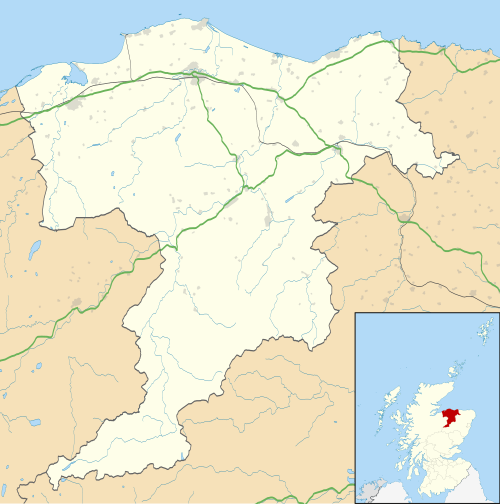
The large majority of Moray's population live in the northern part of the district; only one of its eight wards covers the glens to the south. Elgin is by far the largest town, being home to 25% of the population at the 2011 census.
Largest settlements by population:
| Settlement | Population (2020) |
|---|---|
| Elgin |
25,040 |
| Forres |
9,900 |
| Buckie |
9,010 |
| Lossiemouth |
6,840 |
| Keith |
4,610 |
| Burghead |
1,840 |
| Lhanbryde |
1,830 |
| Fochabers |
1,770 |
| Hopeman |
1,710 |
| Dufftown |
1,590 |
Education
| This section needs expansion. You can help by adding to it. (March 2013) |
There are 45 primary and eight secondary schools in Moray and the council currently has responsibility for educating more than 13,000 pupils. The council's community learning and development team is also involved in arranging a wide range of classes and courses for adult learners. The council also currently operates 15 public libraries, all with free internet and e-mail access, and two mobile libraries, which service users in more remote areas.
Moray is also home to the University of the Highlands and Islands affiliated Moray College, and to Gordonstoun independent boarding school and its accompanying preparatory school, Aberlour House.
Infrastructure
| This section needs expansion. You can help by adding to it. (March 2013) |
Moray Council is also responsible for the maintenance of 1,000 miles of roads, 450 miles of footpaths, 468 bridges, 16,000 street lights and 10,500 road signs.
As a housing authority, Moray Council manages nearly 6,000 council properties and operates a council house waiting list. It also provides housing which has been specially designed, built, or adapted to meet the requirements of certain groups, such as the elderly and those with special needs. The council's development control section, which is part of the environmental services department, deals with thousands of planning applications every year from individuals and organisations seeking permission to erect buildings or adapt existing ones.
Drug issues
In 2020, Scotland had the highest number of drug-related deaths in Europe, almost 3.5 times higher than the rest of the UK.
Figures from the National Records of Scotland show there were 17 drug deaths in the Moray area in 2018 compared to 7 the year before. That compares to 10 in both 2016 and 2015, 2 in 2014 and 5 in 2013. The 2018 figures for the Moray area were the highest since records began in 1996, mirroring the national picture.
In 2019, 12 drug-related deaths were reported - 5 fewer than the record high of the previous year. This represents a drug-related death rate per 1,000 people of 0.12. By comparison, the death rate in neighbouring Aberdeenshire per 1,000 people was 0.08; in Dundee it was 0.36 (the highest in the country); in Glasgow it was 0.35 (the second highest in the country); the lowest in Scotland was Orkney with a rate of 0.06.
Environment

| This section needs expansion. You can help by adding to it. (March 2013) |
Approximately 50,000 tonnes of waste is collected from homes and commercial properties in Moray. Households in many communities benefit from a kerbside recycling service. There are over 60 recycling points located throughout Moray in addition to eight larger recycling centres.
Economy
| This section needs to be updated. Please help update this article to reflect recent events or newly available information. (September 2024) |
Employment
The working population of Moray in 2003 was nearly 40,000: of whom around 34,000 were employees and 6000 self-employed. Of these 34,000, 31% were employed in the public sector, compared with 27% for Scotland and 25% for the UK (the RAF personnel are not included in these figures). Only 18% of jobs are managerial or professional, compared to 25% for Scotland.

Economic performance and development
The gross value added (GVA) in Moray was £1.26 billion in 2003. This corresponds to an output of £14,500 per resident and was 6% below the average for Scotland and 12% below that of the UK.
The diagrams show the strong reliance on the food and drink industry, i.e. the distilling, canned food and biscuit manufacturing industries. The public sector is also very prominent. Of the total GVA of £1.26 billion, food and drink is responsible for 19% while 3% is the Scottish figure and 2% for the UK. Moray is responsible for 9% of the entire food and drink GVA of Scotland. Significant areas where Moray has a larger than average share of national markets are in tourism, forest products, textiles and specialised metal working. In contrast, however, Moray is significantly underrepresented in the business services area at 15% of GVA, while it is 19% for Scotland and 25% for the UK.
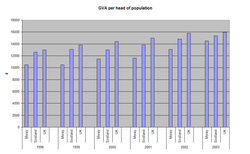 GVA per head of population (1998 - 2003), comparing Moray, Scotland and the whole UK
GVA per head of population (1998 - 2003), comparing Moray, Scotland and the whole UK Industry GVA (2003)
Industry GVA (2003)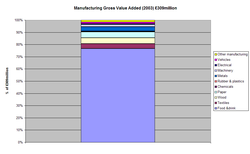 Manufacturing GVA (2003)
Manufacturing GVA (2003)
In March 2014 a tourism strategy was launched by the Moray Economic Partnership aimed at doubling the £95m industry over the next decade. In June 2014 a website (morayspeyside.com) was launched under the auspices of the Moray Chamber of Commerce to support the strategy and provide a one-stop shop for visitors.
Earnings
Compared to Scottish or British levels, average incomes in Moray are low. The average wage in 2003 was £286 per week, which was 12% below the Scottish average and 18% below the British (these statistics exclude the armed forces). These figures reflect the large amount of part-time employment, with fewer qualified workers and less managerial and professional jobs. 16% of residents commute outwards, which is relatively high. Of these, two-thirds work in Aberdeen or Aberdeenshire, mainly in the oil and gas industry. These outward commuters earn significantly more than local workers.
Business base
In 2004, there were around 2,500 VAT registered businesses in Moray, with 75% of businesses employing fewer than five people and about half of firms with a turnover of less than £100,000. 60% of employees are employed in small firms, compared to 48% for Scotland as a whole.
Moray's major companies export their products to other British regions and abroad and many of the smaller companies have direct involvement with neighbouring economies in Aberdeen, Aberdeenshire, and Highland. Also, a large outward-commuting workforce (estimated to be in excess of 5,000 people) derives its income from the neighbouring centres of Aberdeen and Inverness.

Note: 2003 and 2004 data at SCOTDAT was the most up-to-date, as of August 2006
Demographics
An inhabitant of Moray, especially the historic Mormaer of Moray, is called, 'Moravian.'
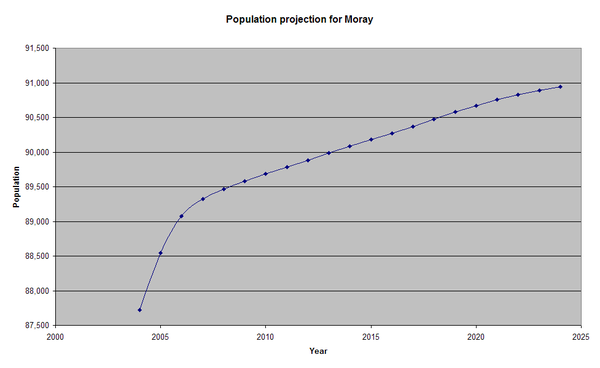
Source: General Register Office for Scotland.
Ethnicity
| Ethnic Group | 2001 | 2011 | 2022 | |||
|---|---|---|---|---|---|---|
| Number | % | Number | % | Number | % | |
| White: Total | 86,175 | 99.12% | 92,263 | 98.89% | 91,055 | 97.60% |
| White: Scottish | 69,948 | 80.46% | 72,470 | 77.68% | 68,785 | 73.73% |
| White: Other British | 14,629 | 16.83% | 16,823 | 18.03% | 18,674 | 20.02% |
| White: Irish | 409 | 0.47% | 430 | 0.46% | 514 | 0.55% |
| White: Gypsy/Traveller | – | – | 79 | 0.08% | 87 | 0.09% |
| White: Polish | – | – | 985 | 1.06% | 1,080 | 1.16% |
| White: Other | 1,189 | 1.37% | 1,476 | 1.58% | 1,915 | 2.05% |
| Asian, Asian Scottish or Asian British: Total | 402 | 0.46% | 599 | 0.64% | 913 | 0.98% |
| Asian, Asian Scottish or Asian British: Indian | 71 | 0.08% | 101 | 0.11% | 199 | 0.21% |
| Asian, Asian Scottish or Asian British: Pakistani | 124 | 0.14% | 149 | 0.16% | 152 | 0.16% |
| Asian, Asian Scottish or Asian British: Bangladeshi | 17 | – | 16 | – | 57 | 0.06% |
| Asian, Asian Scottish or Asian British: Chinese | 151 | 0.17% | 164 | 0.18% | 201 | 0.22% |
| Asian, Asian Scottish or Asian British: Asian Other | 39 | – | 169 | 0.18% | 298 | 0.32% |
| Black, Black Scottish or Black British | 19 | – | – | – | – | – |
| African: Total | 36 | – | 88 | 0.09% | 156 | 0.17% |
| African: African, African Scottish or African British | – | – | 78 | 0.08% | 13 | – |
| African: Other African | – | – | 10 | – | 147 | 0.16% |
| Caribbean or Black: Total | – | – | 57 | 0.06% | 111 | 0.12% |
| Caribbean | 54 | 0.06% | 43 | 0.05% | 44 | 0.05% |
| Black | – | – | 11 | – | 15 | – |
| Caribbean or Black: Other | – | – | 3 | – | 52 | – |
| Mixed or multiple ethnic groups: Total | 150 | 0.17% | 232 | 0.25% | 708 | 0.76% |
| Other: Total | 104 | 0.12% | 56 | 0.06% | 352 | 0.38% |
| Other: Arab | – | – | 26 | 0.03% | 116 | 0.12% |
| Other: Any other ethnic group | – | – | 30 | – | 236 | 0.25% |
| Total: | 86,940 | 100.00% | 93,295 | 100.00% | 93,293 | 100.00% |
Language
The first records on language use in the area indicate that in 1705, most of Moray except for the coast was described as "Wholly Irish & Highland Countreys" and "Ye Irish Parishes in which both languages are spoken." By 1822, Scottish Gaelic had weakened in the area, with only the far south of Moray reporting that, at most, 10% of the population were speaking Gaelic better than English. Records towards the end of the 19th century improved and show that between 1881 and 1921 the percentage of Gaelic speakers in Moray fluctuated as shown in the following table:
| Year | Gaelic speakers (%) |
|---|---|
| 1881 | 2.63 |
| 1891 | 5.64 |
| 1901 | 4.48 |
| 1911 | 2.98 |
| 1921 | 2.08 |
| 1991 | 0.56 |
Since then, it has been consistently below 1%. It was largely replaced by Doric and latterly Scottish English.
See also
Notes
References
- "Council and Government". Moray Council. Retrieved 22 December 2024.
- ^ "Mid-Year Population Estimates, UK, June 2022". Office for National Statistics. 26 March 2024. Retrieved 3 May 2024.
- David Mills, A Dictionary of British Place-Names, rev. edn (Oxford: Oxford University Press, 2011), p. 333.
- Turnock, David (2005). The Historical Geography of Scotland since 1707. Cambridge University Press. p. 19. ISBN 9780521892292. Retrieved 21 August 2024.
- Shaw, Lachlan (1882). The History of the Province of Moray: Volume 1. London / Glasgow: Hamilton, Adams and Co. / Thomas D. Morison. p. 47. Retrieved 21 August 2024.
- "Morayshire County Council: Official name of the county". Aberdeen Daily Journal. 8 May 1919. p. 8. Retrieved 21 August 2024.
- "Quarter-inch Administrative Areas Maps: Scotland, Sheet 5, 1969". National Library of Scotland. Ordnance Survey. Retrieved 22 August 2024.
- ^ "Local Government (Scotland) Act 1973", legislation.gov.uk, The National Archives, 1973 c. 65, retrieved 17 April 2023
- The Inverness and Elgin County Boundaries Act 1870 (33 & 34 Vict c. 16). 1870. Retrieved 21 August 2024.
- "Local Government etc. (Scotland) Act 1994", legislation.gov.uk, The National Archives, 1994 c. 39, retrieved 17 April 2023
- "Land Mass Coverage Report" (PDF). Registers of Scotland. Archived from the original (PDF) on 3 March 2016. Retrieved 16 May 2015.
- "The Lord-Lieutenants (Scotland) Order 1996", legislation.gov.uk, The National Archives, SI 1996/731, retrieved 3 August 2024
- "Location of Moray West, Nairn and Strathspey". UK Parliament. Retrieved 19 August 2024.
- "Location of Aberdeenshire North and Moray East". UK Parliament. Retrieved 19 August 2024.
- "Mid-2020 Population Estimates for Settlements and Localities in Scotland". National Records of Scotland. 31 March 2022. Retrieved 31 March 2022.
- "'Radical rethink needed' on drugs policy". 22 December 2020.
- ^ "12 drug deaths in Moray last year". 15 December 2020.
- GVA = Gross Value Added is the term now used for total wealth created in the regional economy. Measured at basic prices, it is close to what was formerly known as Gross Domestic Product at factor cost.
- "Tourism strategy launched for Moray".
- "Moray tourism website launched - Press and Journal". pressandjournal.co.uk. 27 June 2014. Retrieved 15 March 2018.
- "About Us - Moray Speyside". Archived from the original on 15 July 2014. Retrieved 3 July 2014.
- "Famous Moravians". www.morayconnections.com.
- Team, National Records of Scotland Web (31 May 2013). "National Records of Scotland". National Records of Scotland.
- ^ Census Dissemination Unit, Mimas (5 May 2011). "InFuse". infuse2011gf.ukdataservice.ac.uk. Retrieved 24 June 2022.
- "Scotland's Census 2011 – Table KS201SC". scotlandscensus.gov.uk. Archived from the original on 7 January 2019. Retrieved 3 November 2015.
- "Scotland's Census 2022 - Ethnic group, national identity, language and religion - Chart data". Scotland's Census. National Records of Scotland. 21 May 2024. Retrieved 21 May 2024. Alternative URL 'Search data by location' > 'Local Authority (CA2019)' > 'Moray' > 'Ethnic group, national identity, language and religion' > 'Ethnic Group'
- ^ Withers, C. Gaelic in Scotland 1698-1981 (1984) John Donald Publishers ISBN 0-85976-097-9
- "Welcome to Scotland's Census - Scotland Census 2011". Archived from the original on 4 July 2008. Retrieved 17 March 2011.
Further reading
- A joint report HIE Moray and Moray Council, entitled "Moray 2020: Strategy for the Diversification of the Economy of Moray Following Restructuring of the RAF Bases at Kinloss and Lossiemouth", is available at both web sites.
External links
- Moray Speyside Tourism, the official tourism website for Moray
- Undiscovered Speyside Community Web Site, a portal for all things Speyside
- Moray and Speyside info
| Local government of Scotland | |
|---|---|
| Council areas |
|
| Councils |
|
| List by area, population, density | |
| Local government areas of Scotland, in use 1975 to 1996 | ||
|---|---|---|
| Borders | 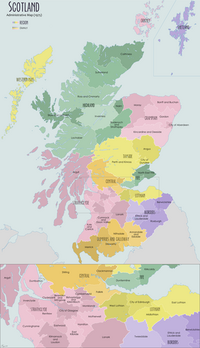 | |
| Central Region | ||
| Dumfries and Galloway | ||
| Fife | ||
| Grampian | ||
| Highland | ||
| Lothian | ||
| Strathclyde | ||
| Tayside | ||
| Island areas | ||
| The island areas were unitary authorities, combining the powers of a region and a district. | ||
